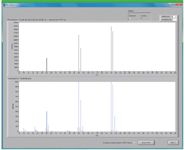Identification of Trace-Level TO-15/TO-17 Air Toxics in Complex Air Samples
Air pollution remains a global concern due to its impact on human health and the environment. Compounds known as "air toxics" are of particular importance in this respect, and US EPA methods TO-15 and TO-17 describe how to test air samples for the presence of these compounds.
Air pollution remains a global concern due to its impact on human health and the environment. Compounds known as "air toxics" are of particular importance in this respect, and US EPA methods TO-15 and TO-17 describe how to test air samples for the presence of these compounds.
In this study, a sample of semi-rural air was analyzed by thermal desorption in conjunction with the BenchTOF-dx™. By monitoring all ions simultaneously across the mass range with an acquisition rate of 10,000 spectra/s, the BenchTOF-dx is significantly more sensitive than scanning mass spectrometers used in SIM mode. The resulting wealth of fragment-ion information is used to the full by processing it with ALMSCO International's TargetView™ software. This employs sophisticated algorithms to eliminate background interference and deconvolute overlapping peaks, allowing confident analysis of trace-level TO-15/TO-17 "air toxics" at the lowest possible levels.
Experimental
Using an Air Server™ (Markes International), 1 L of semi-rural air was pumped from a canister onto the focusing trap of a UNITY 2™ thermal desorber (Markes International). The sample was then desorbed onto a GC column for TOF MS analysis on the BenchTOF-dx (ALMSCO International).
A target library of 62 TO-15/TO-17 compounds was created using spectra imported from NIST, and the TOF-MS data file interrogated to determine matches using TargetView (ALMSCO International).
For more details of the experimental conditions, please see ALMSCO application note ANBT13 (available at http://bit.ly/ALMSCOapps).
Results and Discussion
The chromatogram obtained from the semi-rural air sample (Figure 1) contains many target peaks and unknowns, but also has a significant chromatographic background signal. This background is removed by TargetView, which applies dynamic background compensation (DBC), enhancing the spectral purity and making it much quicker and easier to characterize low-abundance compounds. A sophisticated deconvolution algorithm is then applied, to separate out overlapping components.

Figure 1: Black trace: Original chromatogram for 1 L semi-rural air (offset 500,000 counts). Blue trace: Chromatogram after TargetView processing.
The results were then compared against the library to identify matches. Twenty-three TO-15/TO-17 compounds of wide-ranging abundance were detected in this particular semi-rural air sample, as listed in Table I. Concentrations range from ~5 ppt for trichloromethane (chloroform) to ~1 ppb for styrene.
Taking the case of toluene, the report (Table I) indicates that it has a high matching coefficient of 0.948. This high value is due to the similarity between the spectrum obtained and the library spectrum (see Figure 2) — a key advantage of the BenchTOF-dx.

Table I: The TO-15/TO-17 compounds present in the semi-rural air sample
To provide additional confirmation of the quality of the classical EI spectra obtainable using the BenchTOF-dx, the NIST database was searched for a match with the obtained chromatogram. It was found that the best match is indeed for toluene, with the rating of 888 out of 1000 indicating the quality of the match.

Figure 2: Comparison of obtained spectrum (upper panel) and library spectrum (lower panel) for toluene.
Toluene is relatively abundant in the TIC (~0.5 ppb), but low-level compounds will inevitably present a bigger analytical challenge. Nevertheless, the trace-level (~20 ppt) component trichloroethylene has a matching coefficient of 0.841, despite its low abundance. Figure 3 shows a comparison with the library spectrum.

Figure 3: Comparison of obtained spectrum (upper panel) and library spectrum (lower panel) for trichloroethylene.
Conclusions
In summary, the BenchTOF-dx provides a means of obtaining high-quality mass spectra of trace-level air-sample components. When used in conjunction with TargetView, identification of trace-level TO-15/TO-17 "air toxics" can be carried out with unsurpassed ease, even in complex real-world samples. Interfacing with the NIST database allows rapid confirmation of the identities of library components, and also allows identification of nonlibrary compounds. All these features make the combination of a UNITY 2–Air Server thermal desorption system, GC, the BenchTOF-dx, and TargetView a powerful and versatile system for identifying TO-15/TO-17 "air toxics."
ALMSCO International
Gwaun Elai Medi Science Campus, Llantrisant, RCT, CF72 8XL, UK
tel. +44 (0)1443 233920, fax +44 (0)1443 231531
Website: www.almsco.com

Separation of Ultra-Short and Long Chain PFAS Compounds Using a Positive Charge Surface Column
December 11th 2024A separation of ultra-short and long chain PFAS (C1-C18) is performed on a HALO®PCS Phenyl-Hexyl column along with a HALO®PFAS Delay column which demonstrates excellent retention for both hydrophilic and hydrophobic analytes.















